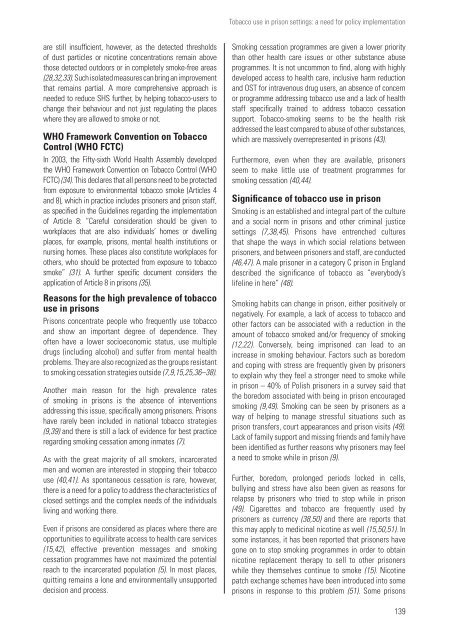Prisons
prisons-and-health
prisons-and-health
Create successful ePaper yourself
Turn your PDF publications into a flip-book with our unique Google optimized e-Paper software.
Tobacco use in prison settings: a need for policy implementation<br />
are still insufficient, however, as the detected thresholds<br />
of dust particles or nicotine concentrations remain above<br />
those detected outdoors or in completely smoke-free areas<br />
(28,32,33). Such isolated measures can bring an improvement<br />
that remains partial. A more comprehensive approach is<br />
needed to reduce SHS further, by helping tobacco-users to<br />
change their behaviour and not just regulating the places<br />
where they are allowed to smoke or not.<br />
WHO Framework Convention on Tobacco<br />
Control (WHO FCTC)<br />
In 2003, the Fifty-sixth World Health Assembly developed<br />
the WHO Framework Convention on Tobacco Control (WHO<br />
FCTC) (34). This declares that all persons need to be protected<br />
from exposure to environmental tobacco smoke (Articles 4<br />
and 8), which in practice includes prisoners and prison staff,<br />
as specified in the Guidelines regarding the implementation<br />
of Article 8: “Careful consideration should be given to<br />
workplaces that are also individuals’ homes or dwelling<br />
places, for example, prisons, mental health institutions or<br />
nursing homes. These places also constitute workplaces for<br />
others, who should be protected from exposure to tobacco<br />
smoke” (31). A further specific document considers the<br />
application of Article 8 in prisons (35).<br />
Reasons for the high prevalence of tobacco<br />
use in prisons<br />
<strong>Prisons</strong> concentrate people who frequently use tobacco<br />
and show an important degree of dependence. They<br />
often have a lower socioeconomic status, use multiple<br />
drugs (including alcohol) and suffer from mental health<br />
problems. They are also recognized as the groups resistant<br />
to smoking cessation strategies outside (7,9,15,25,36–38).<br />
Another main reason for the high prevalence rates<br />
of smoking in prisons is the absence of interventions<br />
addressing this issue, specifically among prisoners. <strong>Prisons</strong><br />
have rarely been included in national tobacco strategies<br />
(9,39) and there is still a lack of evidence for best practice<br />
regarding smoking cessation among inmates (7).<br />
As with the great majority of all smokers, incarcerated<br />
men and women are interested in stopping their tobacco<br />
use (40,41). As spontaneous cessation is rare, however,<br />
there is a need for a policy to address the characteristics of<br />
closed settings and the complex needs of the individuals<br />
living and working there.<br />
Even if prisons are considered as places where there are<br />
opportunities to equilibrate access to health care services<br />
(15,42), effective prevention messages and smoking<br />
cessation programmes have not maximized the potential<br />
reach to the incarcerated population (5). In most places,<br />
quitting remains a lone and environmentally unsupported<br />
decision and process.<br />
Smoking cessation programmes are given a lower priority<br />
than other health care issues or other substance abuse<br />
programmes. It is not uncommon to find, along with highly<br />
developed access to health care, inclusive harm reduction<br />
and OST for intravenous drug users, an absence of concern<br />
or programme addressing tobacco use and a lack of health<br />
staff specifically trained to address tobacco cessation<br />
support. Tobacco-smoking seems to be the health risk<br />
addressed the least compared to abuse of other substances,<br />
which are massively overrepresented in prisons (43).<br />
Furthermore, even when they are available, prisoners<br />
seem to make little use of treatment programmes for<br />
smoking cessation (40,44).<br />
Significance of tobacco use in prison<br />
Smoking is an established and integral part of the culture<br />
and a social norm in prisons and other criminal justice<br />
settings (7,38,45). <strong>Prisons</strong> have entrenched cultures<br />
that shape the ways in which social relations between<br />
prisoners, and between prisoners and staff, are conducted<br />
(46,47). A male prisoner in a category C prison in England<br />
described the significance of tobacco as “everybody’s<br />
lifeline in here” (48).<br />
Smoking habits can change in prison, either positively or<br />
negatively. For example, a lack of access to tobacco and<br />
other factors can be associated with a reduction in the<br />
amount of tobacco smoked and/or frequency of smoking<br />
(12,22). Conversely, being imprisoned can lead to an<br />
increase in smoking behaviour. Factors such as boredom<br />
and coping with stress are frequently given by prisoners<br />
to explain why they feel a stronger need to smoke while<br />
in prison – 40% of Polish prisoners in a survey said that<br />
the boredom associated with being in prison encouraged<br />
smoking (9,49). Smoking can be seen by prisoners as a<br />
way of helping to manage stressful situations such as<br />
prison transfers, court appearances and prison visits (49).<br />
Lack of family support and missing friends and family have<br />
been identified as further reasons why prisoners may feel<br />
a need to smoke while in prison (9).<br />
Further, boredom, prolonged periods locked in cells,<br />
bullying and stress have also been given as reasons for<br />
relapse by prisoners who tried to stop while in prison<br />
(49). Cigarettes and tobacco are frequently used by<br />
prisoners as currency (38,50) and there are reports that<br />
this may apply to medicinal nicotine as well (15,50,51). In<br />
some instances, it has been reported that prisoners have<br />
gone on to stop smoking programmes in order to obtain<br />
nicotine replacement therapy to sell to other prisoners<br />
while they themselves continue to smoke (15). Nicotine<br />
patch exchange schemes have been introduced into some<br />
prisons in response to this problem (51). Some prisons<br />
139


